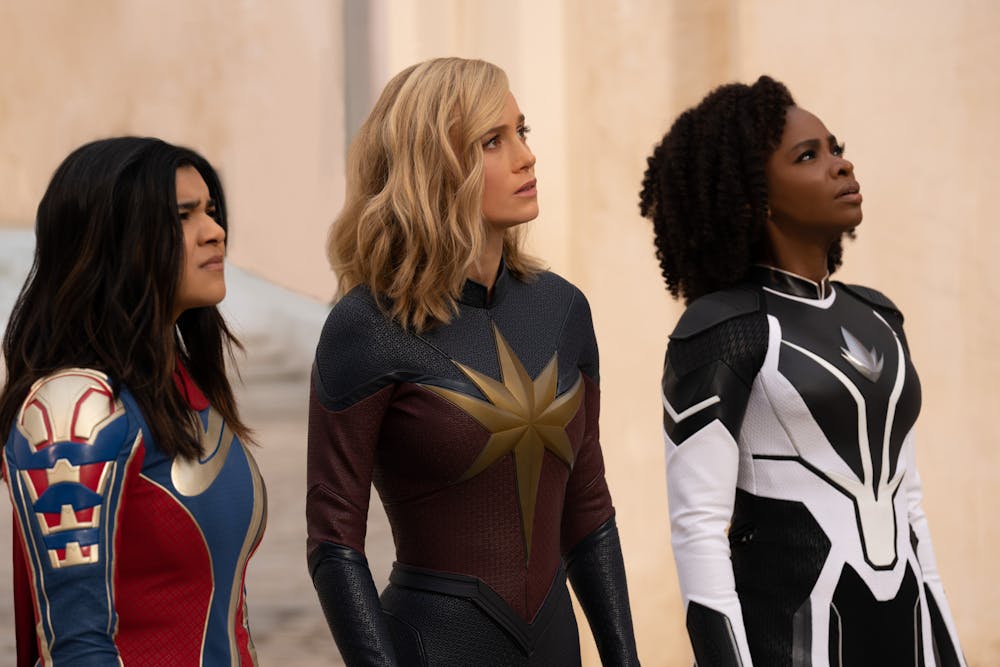“The Marvels” is a good movie, y’all. I’m tired of the hate, of reading rants on social media about how terrible it is and watching videos about how Disney’s “wokeness” — that is, having female leads — has bitten it in the butt. These sexist videos are incomprehensible to me. How is making a movie about women a problem?
Well . . . because the movie has female leads who are written to be realistic and not overtly sexy.
Instead, “The Marvels” features an empowered Black woman (Monica Rambeau, played by Teyonah Parris), a Muslim-American woman of Pakistani descent (Kamala Khan, played by Iman Vellani) and an unapologetic feminist (Carol Danvers, played by Brie Larson). With such a diverse cast, it is inevitable trolls will be upset by the “wokeness” they claim dominates the film. Add a female villain who has the power to rip apart the galaxy (Dar-Benn, played by Zawe Ashton), and it is little wonder the trolls are coming out from under their bridges.
One can see the hate for this series doesn’t start with “The Marvels.” Nor is it about its purported lack of quality. Rewind the clock to 2019, to the release of “Captain Marvel.” Practically from the moment Marvel dropped the trailer, social media erupted. So-called fans complained the character did not smile enough, and ranted against the fact that Captain Marvel, who was once a man in the comics, was cast as a woman. It didn’t matter Carol Danvers had been in the comic books since 1968 and the comic Captain Marvel since 2012. Worse still was the fact the actress playing her, Brie Larson, was an unapologetic feminist who fought for gender equality and diversity. Now, we see the same outrage resurfacing after the release of “The Marvels.”
The somber fact is “The Marvels” is exactly the sort of film Marvel needs to create. For years, their heroines have been sexualized. Remember Black Widow being originally introduced as a sexy secretary Tony Stark lusts after? Future movies portrayed her as “a monster” for being sterile. It took twenty movies to get a woman in the title of a movie (“Ant Man and the Wasp”) and twenty-one to get to “Captain Marvel.” Before that, strong women would be in the movies, yes, but relegated to the position of love interest or cheerleader — motivating or cheering the hero on but rarely doing any fighting. Any fighting that did ensure was sure to include a revealing costume, sexual innuendo or snarky comments about the female character’s relationships.
Which brings me back to “The Marvels.” The last time Marvel attempted to make a feminist moment in “Avengers: Endgame,” in which all the female characters came together to help Captain Marvel, it did not land well. Female fans disliked the implication female characters had to all fight together in order to beat male characters and female superheroes were out of the ordinary. They felt Marvel was pandering to them.
However, “The Marvels” is different. It did not pander to, objectify or kill women off.
Yet there was a bigger difference separating this movie from any which had come before – characters could be women without being so-called “woke” symbols of feminism. Yes, they fought for what they wanted, but they didn’t need to fight to be seen as powerful, as important, as equal. They were already seen that way. They knew they were those things, leaving them free to have conversations that didn’t include men or equal rights, conversations about who they were as people.
Aside from Nick Fury, played by Samuel L. Jackson, who was there for comic relief, there were no men in the movie. The heroes were women. The villain was a woman, a rarity in Marvel films. It was a vision of the future that could be if women are free to be themselves, not tokenized symbols for feminism. They have identifying character traits beyond fulfilling the film’s feminism quota. “The Marvels” isn’t about what characters represent, it’s about who they are.
As a result, the characters were able to have truly deep conversations. Unlike in “Captain Marvel,” Carol Danvers was able to let some of the weight off her shoulders and become just a person. She complained about things. She talked like a normal woman. She radiated humanity in a way that was absent from the first movie, and I got chills when the walls finally broke down and she confessed she didn’t feel good enough to come home, that she had to fix her mistake – and Monica’s reaction was to simply tell her she didn’t need her to be perfect. The conversation struck a deep nerve in my core, as it was a feeling I – and I am sure countless other women around me – have experienced.
So don’t believe everything you read on the internet. “The Marvels” is so much better than it is given credit for. It will make you think. It will make you laugh (especially the Flerkittens scene, which is truly chaos in the best way). But, rarest of all from a superhero movie, it will show you what life can be.




